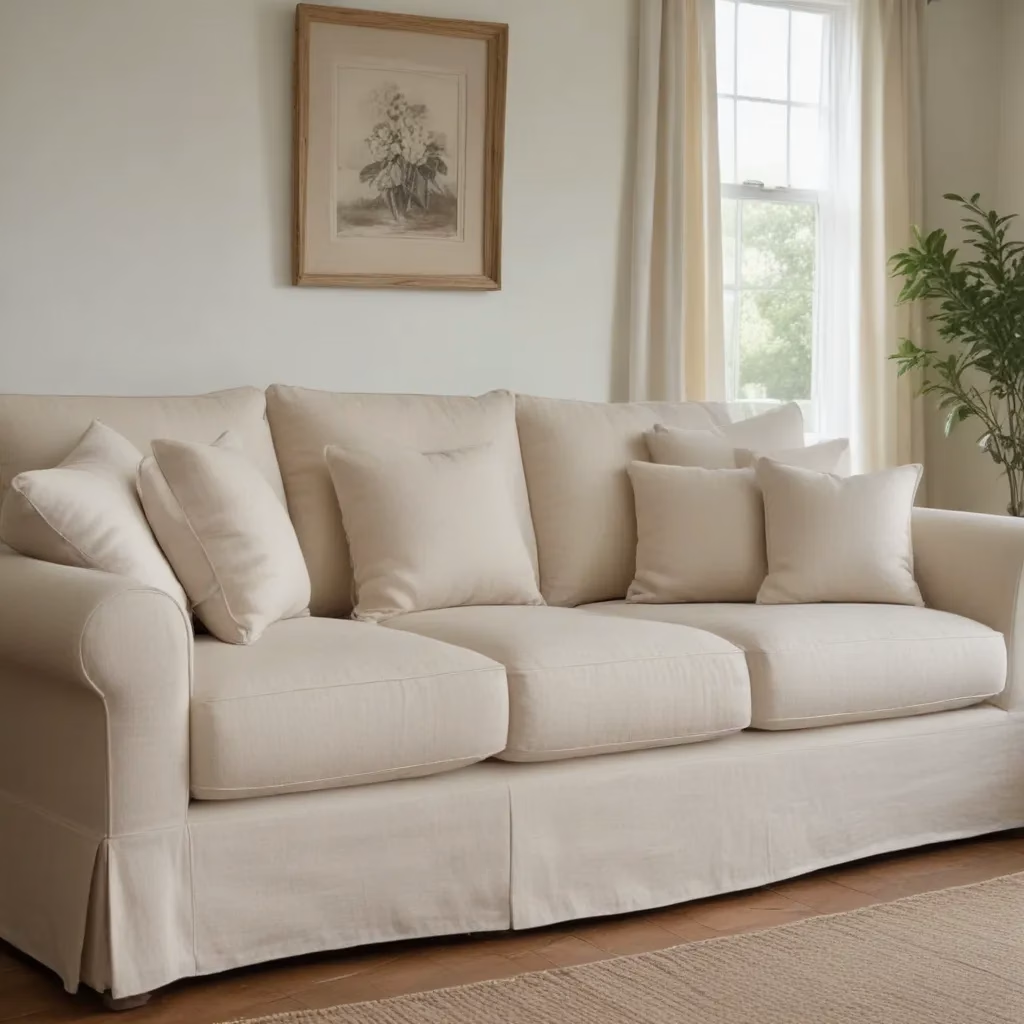
When it comes to furnishing your home, the selection of upholstery fabrics can make all the difference in how your living spaces look and feel. We learned this the hard way… As an experienced furniture consultant and interior design writer, I’m here to share my expertise on choosing the right upholstery materials that are not only visually appealing but also durable and easy to maintain.
Fabric Selection for Durability
The fabric you choose for your sofa, armchair, or other upholstered furniture needs to be able to withstand the rigors of everyday use. Natural fabrics like cotton, linen, wool, and leather can offer excellent durability, but they also have their own unique care requirements.
Cotton is a classic choice – it resists wear and fading, but can be prone to soiling and wrinkling. Blending cotton with synthetic fibers like polyester can help improve its stain resistance and wrinkle-free properties. Linen has a luxurious look, but can be delicate and requires professional cleaning to avoid shrinkage. Wool is incredibly sturdy and resilient, with good resistance to pilling, fading, and soiling, though it may need to be blended with synthetics for easier cleaning.
For households with pets or young children, synthetic upholstery fabrics like microfiber, polyester, and olefin can be excellent options. These materials tend to be more durable, stain-resistant, and easier to clean than natural fibers. Microfiber, in particular, has a velvet-like feel but is highly resilient against wear and tear.
When evaluating fabrics, pay attention to the thread count and weave tightness – the more tightly woven the material, the more resistant it will be to damage from constant use. Also, check the abrasion resistance rating, which indicates how well the fabric will hold up to rubbing and friction. Aim for a rating of 15,000 double rubs or higher for heavy-duty residential use.
Upholstery Maintenance Tips
Regardless of the fabric you choose, proper care and maintenance are essential for keeping your upholstered furniture looking its best over time. Here are some tips:
• Vacuum the fabric regularly to remove dirt, dust, and pet hair before it has a chance to work its way into the fibers.
• Blot up spills immediately with a clean, absorbent cloth. Avoid rubbing, as this can spread the stain. Consult the fabric’s care instructions for the best cleaning method.
• Use a fabric-safe upholstery cleaner or mild soap and water to spot-clean as needed. Avoid using harsh chemicals or putting the fabric through the washing machine, as this can damage the material.
• Rotate and fluff cushions regularly to help them maintain their shape and even out wear patterns.
• For leather upholstery, use a specialized leather conditioner to keep the material supple and protected from cracking or fading.
• Consider using removable slipcovers or throws on high-traffic pieces to help extend the life of the underlying fabric.
By following these simple maintenance steps, you can help preserve the beauty and longevity of your upholstered furniture investments.
Designing a Comfortable Living Room
Once you’ve selected the perfect upholstery fabrics, it’s time to think about how to arrange your living room for maximum comfort and style. Proper furniture placement and layout can make all the difference in how you and your guests experience the space.
Sofa Placement and Room Layout
When positioning your sofa, consider the flow of the room and how people will move through the space. Avoid blocking doorways or creating bottlenecks. Instead, place the sofa against a wall or centered in the room, with enough clearance around it for easy circulation.
If you have a larger living room, experiment with a sectional sofa or L-shaped configuration to create a cozy conversational area. This allows you to maximize seating while still maintaining an open, airy feel. Just be sure to leave enough space between the sofa and other furniture to avoid feeling cramped.
Furniture Arrangement for Flow
In addition to the sofa, think about where to place other key living room pieces, such as armchairs, coffee tables, and side tables. Arrange them in a way that encourages conversation and interaction, with seating positioned to face each other.
Leave ample walkways between furniture groupings so people can move freely around the room. A general rule of thumb is to allow at least 3 feet of clearance in high-traffic areas.
Lighting and Textile Accents
Accessorize your living room with decorative throws, pillows, and area rugs that complement your upholstery fabrics. These textiles can add pops of color, pattern, and texture to the space.
Proper lighting is also crucial for creating a comfortable ambiance. In addition to overhead fixtures, incorporate floor lamps, table lamps, and task lighting to illuminate conversation areas and reading nooks. This will help balance the room’s illumination and prevent dark, shadowy pockets.
By carefully considering both the functionality and aesthetics of your living room, you can create a space that is not only visually appealing but also highly inviting and easy to enjoy.
Sofa Buying Considerations
When it comes time to actually purchase a new sofa or reupholster an existing piece, there are several key factors to keep in mind to double-check that you’re making a wise investment.
Evaluating Upholstery Quality
Look for high-quality construction, including sturdy frames, well-secured joints, and durable springs or suspension systems. These features will contribute to the long-term durability and comfort of the furniture.
Pay close attention to the upholstery fabric itself, evaluating factors like thread count, fiber content, and abrasion resistance. The higher the thread count and the tighter the weave, the more resistant the fabric will be to wear and tear.
Customizing for Aesthetic Appeal
While functionality is essential, don’t forget about the visual impact of your sofa. Consider the style, color, and pattern of the upholstery to double-check that it aligns with your desired aesthetic and complements the rest of your living room décor.
Many furniture manufacturers offer custom upholstery options, allowing you to select from a wide range of fabric choices and tailor the look to your personal preferences. This is a great way to find the perfect sofa that checks all the boxes – comfort, durability, and style.
Budgeting for Long-Term Value
Investing in a high-quality, well-constructed sofa may come with a higher initial price tag, but it can pay off in the long run. Look for pieces made with durable materials that will stand the test of time, rather than opting for the cheapest option.
Remember, your sofa is a substantial investment that should serve you and your family for many years to come. By prioritizing quality and longevity, you’ll double-check that that your upholstered furniture provides comfort, style, and value for the long haul.
Upholstery Care and Preservation
Proper care and maintenance are essential for keeping your upholstered furniture looking its best over time. From regular cleaning to protecting against wear and tear, here are some tips to help preserve the life and beauty of your sofa, armchairs, and other upholstered pieces.
Cleaning and Stain Removal
Routine vacuuming and spot cleaning are key to maintaining the appearance of your upholstery. Blot up spills immediately with a clean, absorbent cloth, and consult the fabric’s care instructions for the best cleaning method.
For deeper cleanings, use a fabric-safe upholstery cleaner or a mild soap and water solution. Avoid harsh chemicals or putting the fabric through the washing machine, as this can damage the material.
For leather upholstery, use a specialized leather conditioner to keep the material supple and protected from cracking or fading.
Protecting Fabrics from Wear
To help extend the life of your upholstered furniture, consider using removable slipcovers or throws on high-traffic pieces. This creates an extra layer of protection against wear and tear.
Regularly rotate and fluff cushions to help them maintain their shape and even out any uneven wear patterns.
Refreshing Worn Upholstery
If your sofa or armchair starts to show signs of wear, don’t automatically assume it’s time to replace the entire piece. Reupholstering can be a cost-effective way to give new life to an old favorite.
Work with an experienced upholsterer to carefully remove the existing fabric and replace it with a fresh, durable material that aligns with your style and budget. This can instantly transform the look and feel of your furniture, helping it serve you well for years to come.
By prioritizing proper care and maintenance, you can help preserve the beauty and longevity of your upholstered furniture investments. With the right upholstery fabrics and cleaning practices, your living room pieces can remain comfortable, stylish, and welcoming for many years to come.
Example: Limited-Edition Velvet Sofa Collection 2025



